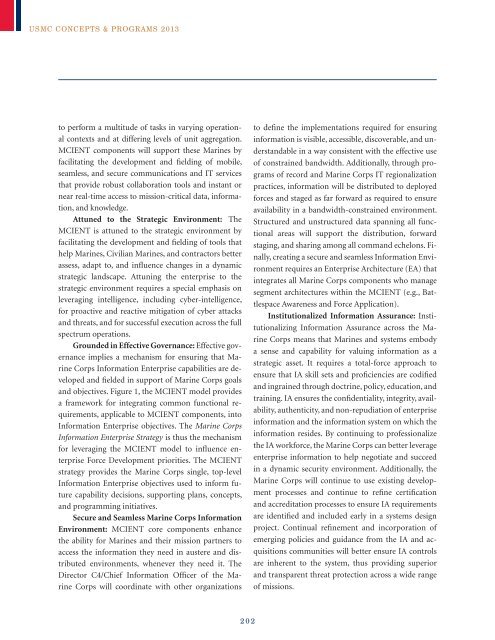USMC Concepts & Programs 2013 - Defense Innovation Marketplace
USMC Concepts & Programs 2013 - Defense Innovation Marketplace
USMC Concepts & Programs 2013 - Defense Innovation Marketplace
Create successful ePaper yourself
Turn your PDF publications into a flip-book with our unique Google optimized e-Paper software.
<strong>USMC</strong> <strong>Concepts</strong> & <strong>Programs</strong> <strong>2013</strong><br />
to perform a multitude of tasks in varying operational<br />
contexts and at differing levels of unit aggregation.<br />
MCIENT components will support these Marines by<br />
facilitating the development and fielding of mobile,<br />
seamless, and secure communications and IT services<br />
that provide robust collaboration tools and instant or<br />
near real-time access to mission-critical data, information,<br />
and knowledge.<br />
Attuned to the Strategic Environment: The<br />
MCIENT is attuned to the strategic environment by<br />
facilitating the development and fielding of tools that<br />
help Marines, Civilian Marines, and contractors better<br />
assess, adapt to, and influence changes in a dynamic<br />
strategic landscape. Attuning the enterprise to the<br />
strategic environment requires a special emphasis on<br />
leveraging intelligence, including cyber-intelligence,<br />
for proactive and reactive mitigation of cyber attacks<br />
and threats, and for successful execution across the full<br />
spectrum operations.<br />
Grounded in Effective Governance: Effective governance<br />
implies a mechanism for ensuring that Marine<br />
Corps Information Enterprise capabilities are developed<br />
and fielded in support of Marine Corps goals<br />
and objectives. Figure 1, the MCIENT model provides<br />
a framework for integrating common functional requirements,<br />
applicable to MCIENT components, into<br />
Information Enterprise objectives. The Marine Corps<br />
Information Enterprise Strategy is thus the mechanism<br />
for leveraging the MCIENT model to influence enterprise<br />
Force Development priorities. The MCIENT<br />
strategy provides the Marine Corps single, top-level<br />
Information Enterprise objectives used to inform future<br />
capability decisions, supporting plans, concepts,<br />
and programming initiatives.<br />
Secure and Seamless Marine Corps Information<br />
Environment: MCIENT core components enhance<br />
the ability for Marines and their mission partners to<br />
access the information they need in austere and distributed<br />
environments, whenever they need it. The<br />
Director C4/Chief Information Officer of the Marine<br />
Corps will coordinate with other organizations<br />
to define the implementations required for ensuring<br />
information is visible, accessible, discoverable, and understandable<br />
in a way consistent with the effective use<br />
of constrained bandwidth. Additionally, through programs<br />
of record and Marine Corps IT regionalization<br />
practices, information will be distributed to deployed<br />
forces and staged as far forward as required to ensure<br />
availability in a bandwidth-constrained environment.<br />
Structured and unstructured data spanning all functional<br />
areas will support the distribution, forward<br />
staging, and sharing among all command echelons. Finally,<br />
creating a secure and seamless Information Environment<br />
requires an Enterprise Architecture (EA) that<br />
integrates all Marine Corps components who manage<br />
segment architectures within the MCIENT (e.g., Battlespace<br />
Awareness and Force Application).<br />
Institutionalized Information Assurance: Institutionalizing<br />
Information Assurance across the Marine<br />
Corps means that Marines and systems embody<br />
a sense and capability for valuing information as a<br />
strategic asset. It requires a total-force approach to<br />
ensure that IA skill sets and proficiencies are codified<br />
and ingrained through doctrine, policy, education, and<br />
training. IA ensures the confidentiality, integrity, availability,<br />
authenticity, and non-repudiation of enterprise<br />
information and the information system on which the<br />
information resides. By continuing to professionalize<br />
the IA workforce, the Marine Corps can better leverage<br />
enterprise information to help negotiate and succeed<br />
in a dynamic security environment. Additionally, the<br />
Marine Corps will continue to use existing development<br />
processes and continue to refine certification<br />
and accreditation processes to ensure IA requirements<br />
are identified and included early in a systems design<br />
project. Continual refinement and incorporation of<br />
emerging policies and guidance from the IA and acquisitions<br />
communities will better ensure IA controls<br />
are inherent to the system, thus providing superior<br />
and transparent threat protection across a wide range<br />
of missions.<br />
202

















